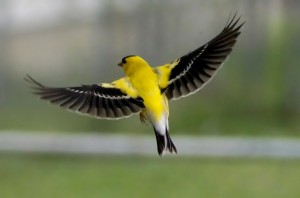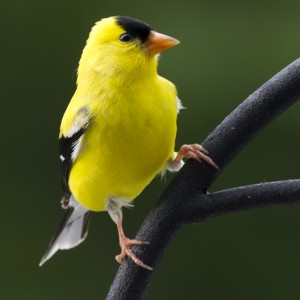Content for this page researched and created by Lindsey Moore
The American goldfinch (Spinus tristis), also known as the “lightning bird”, is a small bird, native to North American. A member of the finch family, adults average about 5 inches in length. Males and females differ in color. During the winter seasons, though, males look more like females (Wild Bird Watching). Typically, the males are bright yellow, and the females have a dull yellow color. The legs and feet of the males and females are orange, or yellow-brown. During breeding season, a female’s plumage is olive-green. Compared to females, males have a longer bill and longer wings (Wildscreen Arkive). These birds weight about 10-20 grams. Their average lifespan is about 3 to 6 years. The maximum recorded was 11 years (Wild Bird Watching). The American goldfinch is the state bird of Iowa, New Jersey, and Washington.
The American goldfinch is very common throughout much of the United States and southern Canada (National Geographic). Their habitat includes fields full of weeds, floodplains, cultivated areas, roadsides, orchards, and backyards (Cornell). They range from the plains, mountains, the Great Lakes, etc. Known predators of the nests for these birds are blue jays, American kestrel, stoat, and the common garter snake (Wildscreen Arkive). They are in the southern parts of the United States mainly during the winter, but they are in Pennsylvania year round! They are in the northern parts of North America mainly in the summer (whatBird). A study was conducted in 2002 in South Dakota, evaluating the changed in cold tolerance in American goldfinches. The study found that American goldfinches display a greater degree of metabolic variation than other birds. One of the main contributing factors is the body size (Liknes).

The diet of the American goldfinches tends to be very strict. They are actually one of the strictest vegetarians in the bird world (Cornell). These birds eat seeds from many different plants, tree buds, berries, and bird food from feeders. The seeds they eat come from composite plants, grasses, and trees (Bird Watcher’s Digest). They are picky eaters and take a long time to adapt to new foods. This is a reason why they are one of the hardest birds to rehabilitate and raise in captivity (International Wildlife Rehabilitation Council).
The late seasonal abundance of their primary foods (seeds) explains why they mate so late into the season. Due to the late mating, goldfinches usually only raise one brood a year. Usually several males are attracted to one female bird. The most common behavior involves the male chasing after the female. These chases may last for twenty or more minutes and cover a large area (Wild Bird Watching).

The male and female American goldfinches travel together searching for suitable nest sites. The female goldfinch builds the nest (Cornell). The nest is made of twigs, rootlets, and plant stems, and usually 4 feet to 20 feet above ground. The female softens the nest by adding soft thistle to the inner lining. The nesting season begins late. The earliest nesting time is late June. Most nesting occurs throughout July, August, and September. The eggs, usually four to six, are incubated by the mother for about two weeks. These eggs are light blue. Mothers tend to lay their eggs in the morning. The parents feed the nestlings for about 12 to 17 days before they fledge (Bird Watcher’s Digest). When the mother is incubating the eggs, she will develop a brood patch (a skin patch without feathers) on her stomach to transfer heat to the eggs (Chipper). During the incubation period, the females tend to be quite tame, refusing the leave their nest and eggs unless there is a major disruption (Holcomb). The adult breeding males and adult non-breeding males differ in the color yellow, making them more easily identifiable (eNature).
These birds are very active, and fly in distinct patterns and make distinct calls in flight. This draws attention to themselves. They are very sociable, and they often gather in flocks with other birds (NatureWorks). The male goldfinch is not like any other finch in North America, especially because of their bold wing pattern. Their “voice” is a series of chattering whistles and squeaks. This includes a tinkling whistle (eNature). Within their territory, the goldfinches are not aggressive. If a predator is in site, the goldfinch does not try to protect their territory. Their reaction is to call others with an alarm sound.

Destruction of forests and agricultural fields represent serious habitat stresses on many animals, but it generates perfect habitats for goldfinches. In a three-year study conducted in Ohio, the decline of agriculture near the city of Toledo created a perfect habitat of the goldfinches! This is because the fields that were previously used became their ideal place to live. The fields that were previously tilled several years before caused growth of numerous thistles and forbs. This is the source for nesting sites and for food. Over the three years, 120 nests were started, 107 nests completed, and 71 had eggs laid in them (Holcomb).
These goldfinches are not bothered by human activity. They can be found in backyards everywhere! They can live as caged birds, but a study shows that there are many behavioral changes that occur when they are in captivity. In this study, two males and three females were caged together. They were ten days old when taken from the nest. They were confined to a small cage for two months, then moved into a flight cage. Watching the behavior of the birds, there were signs of aggression between them. They would peck at each other, often directed towards the head or the side of the bird. In addition, the study showed that the male birds were more aggressive than the female birds. Finally, the study showed that social hierarchy in the caged birds was present. To “win” an encounter, the activity of the opponent must be disrupted and disturbed. The birds were found to be very territorial (Coutlee).
General References:
“American Goldfinch”. All About Birds: Cornell Laboratory of Ornithology. 2015. Web. 23 September 2016.
“American Goldfinch”. Bird Watcher’s Digest. N.d. Web. 23 September 2016.
“American Goldfinch”. Chipper Wood Bird Observatory. 2002. Web. 23 September 2016.
“American Goldfinch”. eNature. 2007. Web. 23 September 2016.
“American Goldfinch”. International Wildlife Rehabilitation Council. N.d. Web. 23 September 2016.
“American Goldfinch”. National Geographic. 2006. Web. 23 September 2016.
“American Goldfinch”. whatBird. 2013. Web. 23 September 2016.
“American goldfinch”. Wildscreen Arkive. N.d. Web. 23 September 2016.
“American Goldfinch – Carduelis tristis”. NatureWorks. N.d. 23 September 2016.
“American Goldfinch Habits”. Wild Bird Watching. N.d. 23 September 2016.
Scientific References:
Coutlee, Ellen L. “Agonistic Behavior in the American Goldfinch.” The Wilson Bulletin. (1967): Volume 79, No. 1, pp. 89-107.
Galligan, Edward W., Travis L. DeVault, and Steven L. Lima. “Nesting Success of Grassland and Savanna Birds on Reclaimed Surface Coal Mines of the Midwestern United States.” The Wilson Journal of Ornithology 118(4). (2006): 537-546.
Holcomb, Larry C. “Breeding Biology of the American Goldfinch in Ohio”. Bird-Banding. (1969): Volume 40, No. 1, pp. 26-44.
Klem Jr., Daniel, and Peter G. Saenger. “Evaluating the Effectiveness of Select Visual Signals to Prevent Bird-window Collisions.” The Wilson Journal of Ornithology 125(2). (2013): 406-411.
Liknes, Eric, et. al. “Seasonal Acclimatization in the American Goldfinch Revisited: To What Extent Do Metabolic Rates Vary Seasonally?”. The Condor. (2002): Volume 104, No. 3, pp. 548-557.
McGraw, Kevin J., and Alexander J. Gregory. “Carotenoid pigments in male American goldfinches: what is the optimal biochemical strategy for becoming colourful?” Biological Journal of the Linnean Society. (2004): 273-280.
Middleton, A. L. A. “Effect of Cowbird Parasitism on American Goldfinch Nesting”. The Auk. (1977): Volume 94, No. 2, pp. 304-307.
Middleton, Alex L. A. “Age Determination in the American Goldfinch.” A Journal of Ornithological Investigation. (1974): Volume 45, No. 4, pp. 293-400.
Middleton, A. L. A. “Effect of Cowbird Parasitism on American Goldfinch Nesting”. The Auk. (1977): Volume 94, No. 2, pp. 304-307.
Murphy, Troy G., et al. “Same trait, different receiver response: unlike females, male American goldfinches do not signal status with bill colour.” Animal Behaviour 93. (2014): 121-127.
Image Bibliographies
Flickr. Yahoo. Web. 23 September, 2016. <https://www.flickr.com/photos>
(Use via Creative Commons)
- American Goldfinch (gutenfrog) (creative commons)
- American Goldfinch In Flight (Frank Boston) (creative commons)
- American Goldfinch looks up (Ano Lobb) (creative commons)